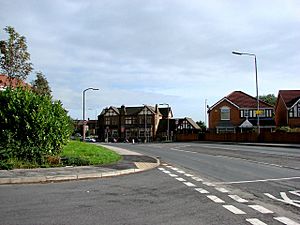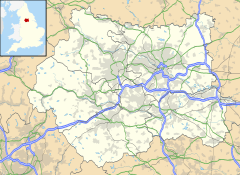Robin Hood, West Yorkshire facts for kids
Quick facts for kids Robin Hood |
|
|---|---|
 The Halfway House, Robin Hood |
|
| Population | 3,573 |
| OS grid reference | SE325275 |
| Metropolitan borough | |
| Metropolitan county | |
| Region | |
| Country | England |
| Sovereign state | United Kingdom |
| Post town | Wakefield |
| Postcode district | WF3 |
| Dialling code | 0113 |
| Police | West Yorkshire |
| Fire | West Yorkshire |
| Ambulance | Yorkshire |
| EU Parliament | Yorkshire and the Humber |
| UK Parliament |
|
Robin Hood is a small village located in West Yorkshire, England. It sits right between the cities of Leeds and Wakefield. You can also find it near the towns of Rothwell and Lofthouse.
The village is part of the Ardsley and Robin Hood area. This area is looked after by the Leeds City Council. It is also part of the Leeds South West and Morley area for the UK Parliament.
Many people believe the very center of Robin Hood is the Halfway House pub. This pub is at a main crossroads where the A61 and A654 roads meet. It got its name because it is exactly halfway between Leeds and Wakefield. It's about 4 miles from each city along the A61 road. This pub has been there for hundreds of years.
Contents
Village History
Robin Hood village was once part of a nearby village called Carlton. The first people who lived here were mostly miners and quarry workers. This means the village grew because of its strong mining history.
At its busiest, the mines here employed hundreds of workers. They worked for a company called J&J Charlesworth. However, the last mine in Robin Hood closed in the 1960s. In recent years, many new homes and businesses have been built. The population of Robin Hood was about 3,573 people in the 2011 census.
How Robin Hood Got Its Name
The name "Robin Hood" was first used for a spring or well. This well was near the old stone quarries. It had a water trough and an iron ladle chained to it. The well is no longer there. People think it was covered up by waste from the quarry.
However, it is believed that the well still flows underground. It helps feed the local streams in the area. Some local people thought that a special well-dressing ceremony might have happened there. They also thought a country dance called "Robin Hood" might have been performed there.
The Folk Hero Connection
This area might have a link to the famous medieval folk hero, Robin Hood. Some of the old stories about Robin Hood mention a place called "Outwoods." This could be Outwood, which is a place near Wakefield. The old stories also talk about "Stane Lea." This might be the nearby village of Stanley.
Also, most of the first Robin Hood ballads say he was active in and around Barnsdale forest. This forest is close to Wakefield and the areas around it.
Mining in Robin Hood
People have been mining in Robin Hood since the late 1600s. The most famous mine was Robin Hood Colliery. It was located across from the Halfway House pub. It was on land between the A61 and Thorpe Lower Lane A654.
This mine opened in 1854. It was run by J&J Charlesworth. This company owned many large coal mines in the area. Many of their mines were named after their daughters. Robin Hood Colliery was known as "Jane Pit." The mine closed in the 1960s. It had been taken over by the National Coal Board in 1946. The mine buildings stayed empty until the 1980s. They were used to help air flow in other main mines. Now, a large housing estate stands where the mine used to be.
Quarries and Brickworks
Robin Hood also had large stone quarries and a brick factory. The main quarry was called "Robin Hood Quarries." It was located to the left of Thorpe Lower Lane, where it meets Middleton Lane. This quarry operated from the late 1800s until the 1950s.
A company called Armitage Brickworks was connected to the quarry. Their offices and stone yard were behind the Robin Hood Colliery. They stretched up Thorpe Lower Lane towards the quarries. Much of this old site is now covered by the M1 Motorway, which was built in the 1960s. Their main brick factory was next to the quarries. It was further along Middleton Lane where it meets Thorpe Lane.
Robin Hood Train Station
Robin Hood used to have its own train station for passengers. It was located between Leadwell Lane A654 and Matty Lane. Matty Lane is now called Hopefield Walk. The station opened in 1904 but only stayed open for 6 months. It was still used for special trips and for carrying coal. The station was finally closed and taken down in the 1960s.
The station was part of a big network of railway lines. These lines operated in the Robin Hood, Lofthouse, and Rothwell areas. This network was known as the East and West Yorkshire Union Railway. The railway was mainly built to carry coal from the mines. It connected all the major coal mines in the area. It started at Lofthouse and joined the Midland Main Line near Stourton in Leeds.
A large raised bank carried the railway from the A61 near the Gardeners Arms Pub. It went through to Leadwell Lane A654. There, a bridge crossed over and led into the station. This raised bank still stands today. It is now part of the Rothwell Greenway. Half of the old Leadwell Lane bridge still stands at the end of the bank.
There were many smaller railway lines that branched off this main line. These were all over the Robin Hood area. One crossed the A61 at a place called Robin Hood Bridge. This is where West Beck flows under the road. There was another road crossing on Thorpe Lower Lane. It was just before the current M1 underpass. There was also a large railway junction beyond Robin Hood Station towards Rothwell. Other branches went from Thorpe Lower Lane to Castle Pit. This pit was off Middleton Lane. They also went to the Armitage Brickworks and Robin Hood Quarries.
Not much of this railway line is left today. You can find a few rails buried under Milner Lane. There are also overgrown banks and cuts along the route to Rothwell.
Old Communication Buildings
There was a large GPO Telephone Repeater Station on the corner of Sharp Lane. This is where it meets the A61 Wakefield Road. This building was used to make telephone signals stronger. It also had an RAF Station behind it. This was known as "RAF Rothwell Haigh."
It was a big concrete building with strong, blast-proof doors. It could work on its own, with its own generators and water. It was part of the country's main military communication network. It was used from the 1950s to the 1990s. The GPO Repeater building was taken down around 2007. The concrete low building is still there today. It is now on private land. It was originally a command center for the CEGB.
Local Football Club
Robin Hood Athletic Football Club won the West Yorkshire Football League Division One in 2013–14. Since then, they have played in its Premier Division.
The team plays at the Coach Ground. This ground is just behind the Coach and Horses pub on the A61. The Robin Hood Athletic Junior FC also plays at the same ground.
Famous People From Robin Hood
- Karl Davey
- Mark Davey
- Ernie Field
- Sidney Parkinson
See also
 In Spanish: Robin Hood (Yorkshire del Oeste) para niños
In Spanish: Robin Hood (Yorkshire del Oeste) para niños


